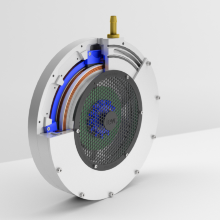Contactless rotating energy transformers can be used whenever the energy transfer to a rotating system by means of slip rings causes technical or economic problems. One application example is the transfer of energy to the rotor of an electrically excited synchronous machine. Usually, contactless rotating energy transformers are built up by means of so-called pot cores and therefore quickly reach a limit with the variance of the installation space and the maximum transmittable power.
At the Institute of Electrical Energy Conversion, a completely new concept of rotating inductive energy transmission line was designed which takes costs, speed stability, efficiency, and weight into account. Compared to other established contactless transformers, the usage of expensive and heavy ferrite materials could be significantly reduced without significantly increasing the losses. The principle of the transformer is based on an incompletely pronounced flow of individual ferrite plates and a winding arrangement with a defined magnetic flux curve. The combination of this unpronounced flow guidance by means of individual ferrite plates and the winding arrangement ensures a relatively high coupling factor as well as relatively low eddy current losses in the aluminium with a massive reduction in material input.
The rotating inductive energy transmission path can be scaled and adapted for applications with almost any speed, diameter, and power. Due to the construction with single ferrite plates, constructions with a very large free internal passage can be implemented. The replacement of maintenance-intensive and expensive slip ring systems, such as in electrically excited synchronous machines, are possible applications.



